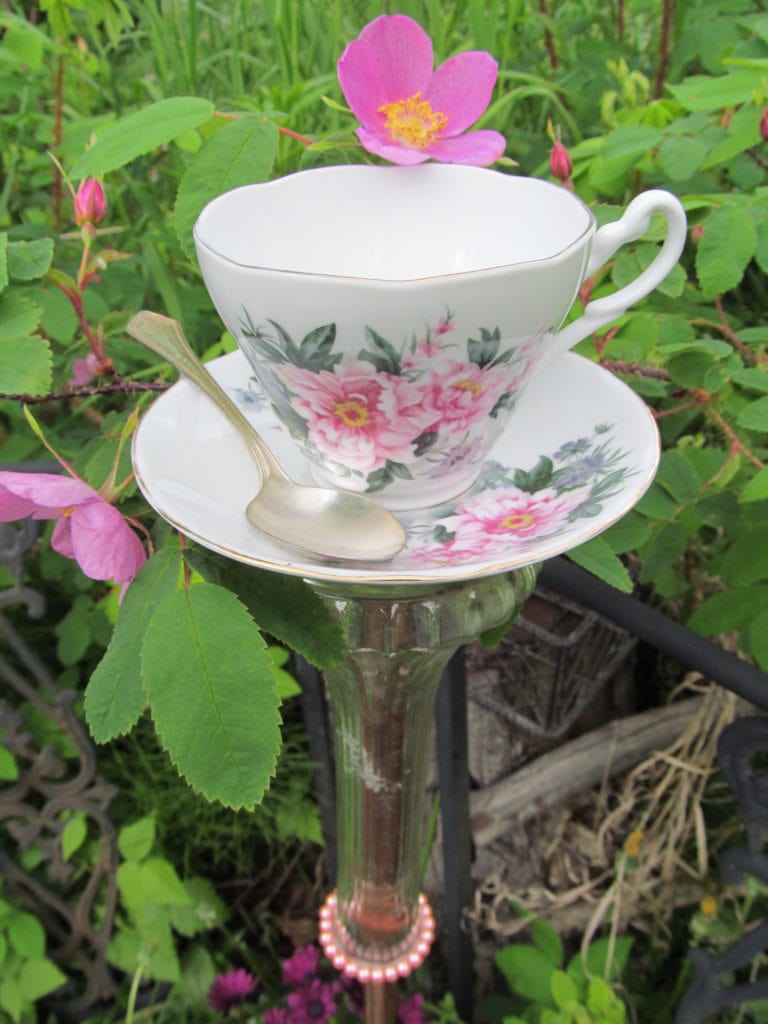
Why would anyone care to know why the glue didn’t work? Lots of articles are written about how to make garden art. But how many are about things that can go wrong with glue? Or even what to do about it?
It’s frustrating when that happens, especially when you’re eager to try a craft project for the first time. But taking the time to figure out what went wrong can be a positive step that will ultimately take your crafting skill to the next level.
Glue and garden art
This article is written specifically for those who love to make garden art: glass dish flowers, garden totems, teacup stakes, birdbaths, and teapot decor. Things involving glass and ceramic crafts in outdoor environments.
It’s usually no mystery. Most of the time, there’s a simple reason behind a glue failure. And sometimes there’s that rare set of circumstances…the ones that leave you scratching your head. But trust me, it’s worth investigating!
- We’ll cover the common and un-common reasons why glue fails causing an art piece to come apart.
- Additionally, this article will address the two primary glues/adhesives associated with glass garden art: E-6000 and GE’s 100% Silicone II.
Overview: Problems with glue
We’ve all watched tutorials on You Tube or found craft ideas on Pinterest. But garden art can be more fussy than your average craft. Furthermore, the person demonstrating the craft or writing the instructions doesn’t necessarily use the right glue. He or she doesn’t always explain how the glue works or the proper way to apply it.
Here are some of the more common reasons why you may have encountered a problem with glue:
- Wrong glue for the project
- Not allowing glue to thoroughly cure before putting art piece outside
- Using too little glue or not applied properly
- Not enough surface-to-surface contact for secure bonding
- Substances on the surface that interfere with bonding (wax, grease etc)
- Glue compromised by hot outdoor temperatures
It’s both surprising and disappointing when glue fails because it was not the outcome you expected. Whatever you do, don’t throw in the towel!
Weather, glue and garden art
Rain is the first thing that comes to mind when considering what glue to use for outdoor garden art; it should be water-proof. You also want it to work for glass and be strong.
Now, there are many glues/adhesives that are water-proof. Many are made for specifically for glass and many are strong-bonding. But toss in the SUN and you’ve got a whole other issue! Would you believe how many craftsmen forget about the sun?
here comes the sun
Here’s a quick history I learned while doing my own research on making glass dish flowers. Back when dish flowers were first being introduced as garden art, crafters had a lot of problems with glue. Their dish flowers were not holding up very well outside. Initially, they thought the glue wasn’t strong enough. When in reality, the glue had softened after a few days of basking in intense heat sending heavy, glass plates crashing to the ground. Other glues simply dried out over time and crumbled apart.
So there’s a lot more factors to consider besides just “water-proof”.
The SOLUTION is found in GE’s 100% Silicone II. It’s actually not a glue but a sealant. Silicone is made to seal around the outside edge of a window. Therefore it meets ALL the critical criteria: It’s strong bonding for glass and ceramics, it’s water-proof and sun-proof. (Scroll down for more tips on using Silicone)
TIP: Use a SUN-PROOF adhesive for outdoor garden art. Always read the fine print on the package (or look it up on-line) to see if the product is suitable for exterior and can withstand higher outdoor temperatures.
Another SOLUTION if you are making a dish flower, is to use the drill method of construction, rather than to glue an item onto the back of the plate in order to attach it to a post. (SEE my tutorial “How to drill a plate”)
Surface to surface contact
You may have heard the old advertising slogan: “Just a dab will do ya”. When it comes to garden art, a dab may be too little glue. Glass and ceramics have a reputation for being a little wonky. Some come through the manufacturing process with a slight uneven edge or bulge or dip in the center that’s barely noticeable.
When a dish is pressed down onto another surface, the glue spreads out. If there’s even the slightest hollow, or slope, or texture, the glue runs off the surface and a secure connection isn’t made. Now, it may be alright for awhile. But should you go to pick it up and there’s some torque upon it, the glue might not be bonded adequately and it will come lose.
Weight
Some glues, like E-6000 are of thinner consistency. It’s just fine for something light. But, if you have a large, heavy or bulky item with just a small area of contact, it may not be enough for the weight of an item. I’ve had that happen more than once. Thankfully, nothing broke, but I had to rearrange my piece to compensate.
The same goes for making garden stakes with copper pipe. It’s a common method on Pinterest or You Tube tutorials. A small, light-weight tea cup may be fine. But a large plate or teapot balanced on a 1/2″ diameter post may not be long lived. That little cap simply may not provide enough surface contact for the long haul. Some glues even have a poor reaction to certain metals and may resist bonding.
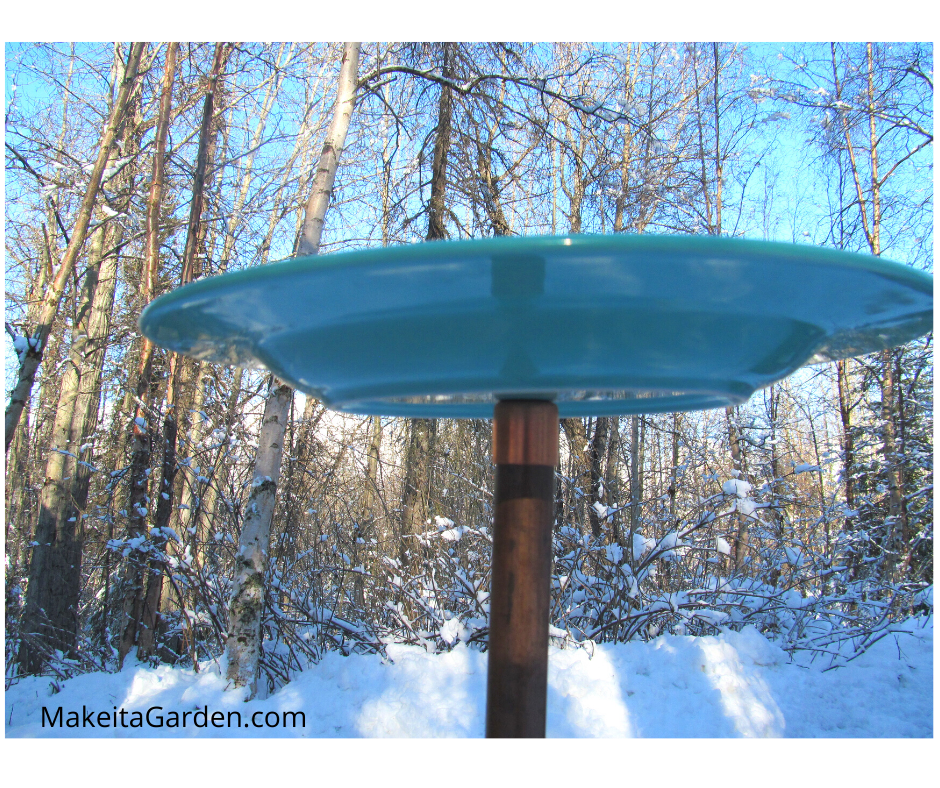
Other problems with bonding
- Shiny Surface. Some glues don’t bond well with a shiny surface, like metal. SOLUTION: Try lightly buffing with sand paper.
- Slippage: It takes several minutes for most glues to begin to set up. If the object you’re gluing shifts during this process, it may weaken the bond. SOLUTION: use something as a weight to hold in position and prevent slipping. This will also keep your art piece perfectly lined up and balanced.
- Remnant substances on the surface frequently interfere with bonding. Grease, grime, candle wax, oil. SOLUTION: Wash dishes well and inspect carefully before starting your project. If using candle stuff, it can be hard to see wax on the surface. Use your hand to feel for presence of wax or any sticky substance.
Un-Common problems with glue
It’s just plain smart to read the fine print on the package or go to the website and get the basics on the product before using it. Whip out your phone and go to the company web site.
When the manufacturer says: adheres to “MOST” metals or ‘most’ wood or ‘most’ surfaces, it means you can occasionally expect something out-of-the-blue not to work. (not to “bond”). It implies there may be some exceptions.
The chemical complexities of glue
Like the ingredients on the back of a cereal box, different glues contain different chemicals and different amounts of a chemical in their product. And they are each intended for a specified use. Here are some rare problems you may encounter when making garden art.
METAL
Sometimes, a glue/adhesive will resist bonding to certain metals. Nickel, zinc, copper, brass, silver plate, aluminum. It’s not the glue’s problem. Depending on the country of origin, metal impurities (lower grade) may be a factor. Other times, a metal may have other ingredients mixed in that are incompatible with the glue. But again, I stress this is rare!
I’ve only had that happen once. It’s quite uncommon, but still something to take into account if your glue fails.
INCOMPATIBLE WITH OTHER GLUES
It’s rare that you will use two different glues that may come into contact with one another, but I sure learned a thing or two conducting a little experiment. I was using a unique metal vase for a whimsical, little patio table. In gluing a ceramic dish to the top of the vase, I decided to use E-6000 for the inside rim thinking it would bond better with metal. Then, seal around the outside edge with 100% silicone to secure the two pieces together. In the end, not a good idea.
At first, everything seemed fine. I allowed the glue to thoroughly dry at room temperature before setting it out on the porch. I even picked it up and moved it around a few days later. But about a week later, I picked it up again and felt something move. It wasn’t the glass tabletop, but some connection in the base that was loose.

On closer inspection, I discovered the problem. Sure enough, the little green scalloped plate twisted right off the top of the blue, metal vase. The glue was all soft and mushy. As much as I tried to keep them separate during the application, the thinner E-6000 likely squished out thru a hairline gap and contacted the sealant.
Two different products, two different combinations of chemicals that cancel each other out. Lesson Learned!
Other conflicting substances
Another time, I used a cute little perfume bottle as a center in one of my more whimsical dish flowers. Though the vessel looked like it had been empty for quite some time, there was a still a strong scent on the inside. I washed it out several times allowing it to air dry. But after a few weeks, the bottle came lose. So I decided to try again with a different glue. Same thing happened.
I concluded that the oils in the perfume somehow leached out of the bottle preventing the glue from curing. I examined the bottle up close and didn’t see any cracks, so maybe a reaction to ‘fumes’? This one still perplexes me!
Using Silicone for garden art
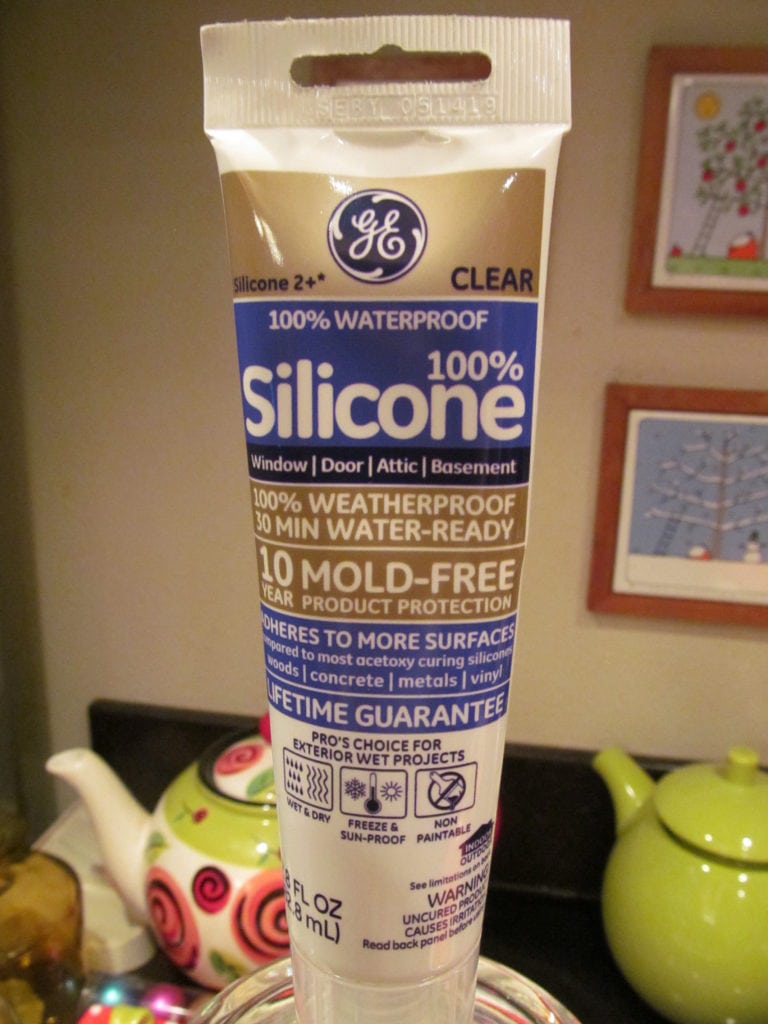
As mentioned above, GE’s 100% silicone meets all the important criteria for outdoor garden art. It’s strong-bonding to glass and ceramics, is water-proof and SUN-proof. The manufacturer states it is good for up to 400 degrees. Over the years, it has risen to become the #1 recommended “glue” for garden art (though it is actually a sealant, not a glue).
Description: Silicone is thick and non-runny which makes it wonderful to work with. It does not have a strong odor, either! The only reason why some crafters don’t like it is because the product is not completely clear. Although the package says “clear”, it’s actually kind of milky in color, which is as “clear” as silicone can get.
Silicone is made with slightly different formulas for inside tub/shower/sink, or other interior uses. One those formulas is for EXTERIOR. They are easy to confuse. Many craft demonstrators use the wrong formula. The Exterior one has the blue label. (SEE image above) Make sure it says “clear”.
Best technique to apply Silicone
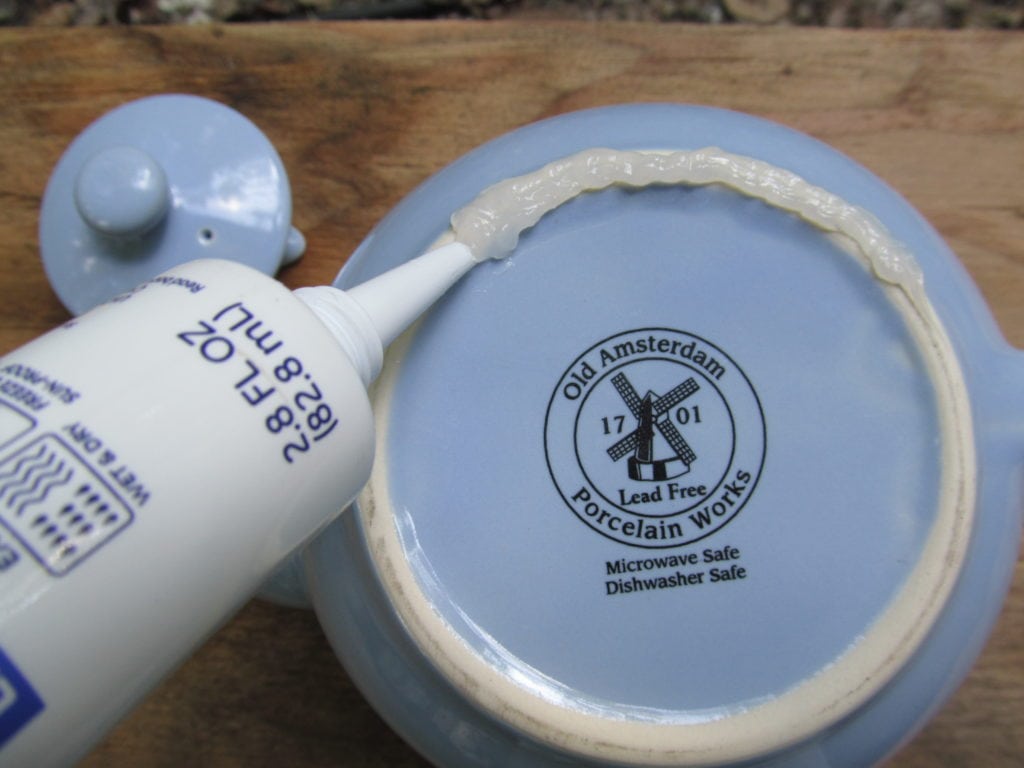
Dish Flower Makers: Don’t just put a glob in the center! Lay a bead around the entire rim. It’s the rim that will connect with the other plate because it sits higher.
Totem or Birdbath Makers: allow the silicone to squish out between surfaces. This is good! Then, use your finger and smooth the bead around the edge using a light pressure to push the glue into the gap between the two pieces being connected. The result is a smooth, professional finish. When dry, the sealant is hardly noticeable.
Silicone usually dries in 24 hours, but a thicker bead may take 2-3 days to fully cure. I always give my artwork the benefit of the doubt.
Problems with silicone
According to the manufacturer, there are ‘some’ metals that react to the chemicals in silicone that cause it not to set up…not to “cure”. It’s rare though, and I’ve seldom encountered any issues with Silicone. It’s quite consistent.
Silicone may not be chemically compatible with certain other adhesives, oils, or substances it comes into contact with.
Using E-6000
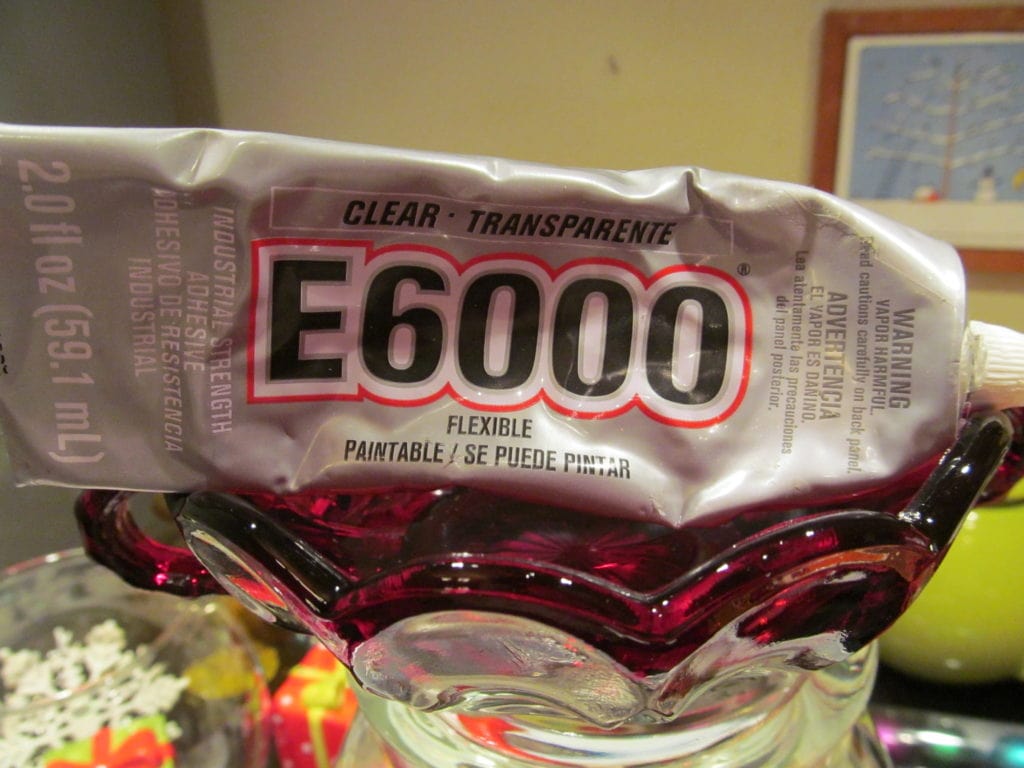
E-6000 is a true glue and the other most commonly used adhesive for glass garden art. It’s preferred for glass because unlike Silicone, E-6000 dries crystal clear. You cannot see the glue!
But it’s also a completely different chemical composition and consistency than silicone. E-6000 is thin and runnier and the bead tends slide off a surface. It’s also tends to be stringy and has a strong odor that some people react to.
Still, E-6000 is strong-bonding and dries to a rubbery consistency. It isn’t made to endure quite the high temperatures that Silicone does. The manufacturer says 180 degrees.
Best technique to apply E-6000
Dish flowers & Totem Makers: Like silicone, apply a bead all the way around the outer edge. Don’t just put a glob in the center. Aim for optimum surface to urface contact, especially since E-6000 is thin.
It also tends to slide around and takes a few minutes for the glue to set up. Recommend using a weight or holding firmly in place until it begins to set up.
Problems with E-6000
E-6000 has a low heat rating which means that it will likely fail in hot climates. Your dish flower may appear to be just fine for awhile, but after day after day of absorbing and retaining heat, the glue melts like butter and the art piece falls apart.
If you like in places like Texas, Arizona, Southern California, even parts of Florida, do not use E-6000 for outdoor garden art. Instead, substitute 100% Silicone which is heat-rated for 400 degrees.
Additionally, E-6000 really shrinks as it dries, and can pull tight enough with pressure to crack thin glass.
In making a glass globe decoration for Christmas, I had this cute figurine of a bear couple ice skating together. I used a little 2″ mirror from the craft store for the skating rink. Then glued the mirror to the bottom of the globe and the bear couple to the mirror with E-6000. The next day, the mirror was cracked, leaving this gal stumped and baffled. How could the mirror have broken, I wondered?
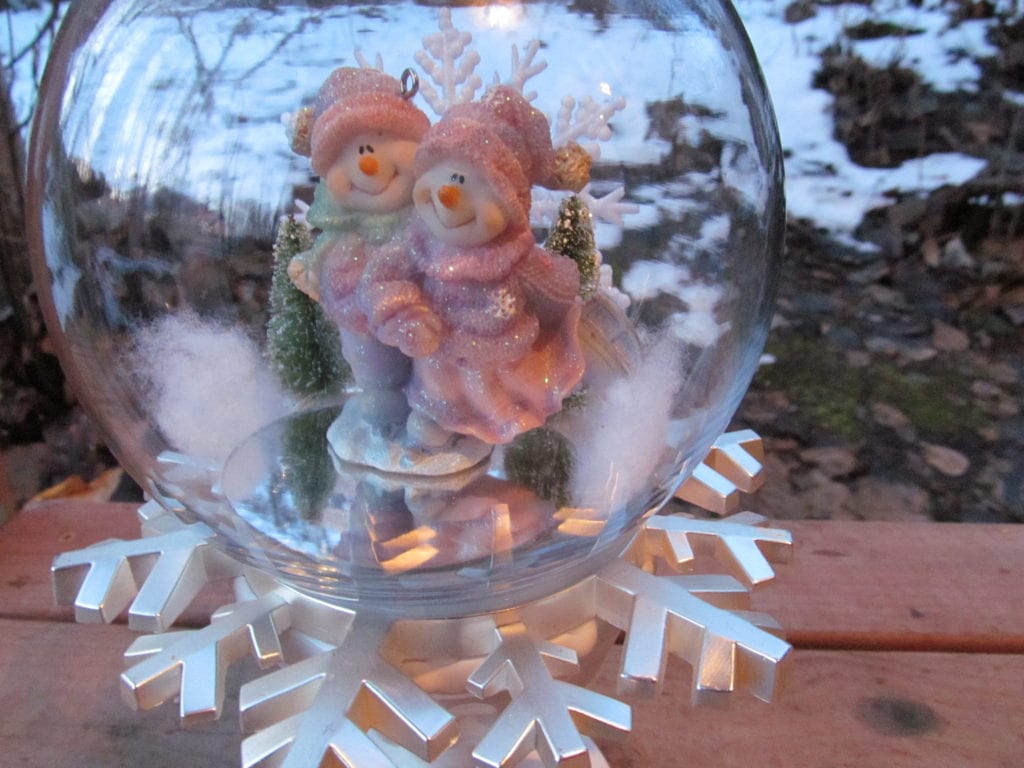
You know me; when something doesn’t work, I have to investigate. I replaced the mirror and used the silicone instead. Voila!
But that’s not the fault of the glue. But it shows that E-6000 really grips, and you want that! I’ve had no problems at all using E-6000 for the thick, sturdy types of glass I generally use for outdoor garden art. But again, just because a product is made for gluing glass doesn’t necessarily mean its the right glue for a particular project.
Final thoughts
I hope you’ve picked up some good information and solutions for your glue problems. You learn how things work, but best of all, taking the time to figure out what went wrong will improve your crafting skills.
Despite the occasional frustrations, these “problems” can be the very thing that makes arts and crafts such a rewarding pursuit.
A few things to remember
- read the package or google the product to make sure you’re using the right glue for your project.
- Make sure your glue can withstand high outdoor temperatures. Remember that glass and ceramics absorb heat and retain heat.
- Use good glue techniques that improve surface to surface contact so your art works are solid and secure.
- Make sure surfaces are clean and free from oils, gummy residue and wax. Buff shiny metal surfaces with light sand paper to give glue more grip.
Has this article been helpful? Has it resonated with you? What are your thoughts and experiences with Glue? Please take a moment to comment below.
Pretty garden art to make
The form you have selected does not exist.
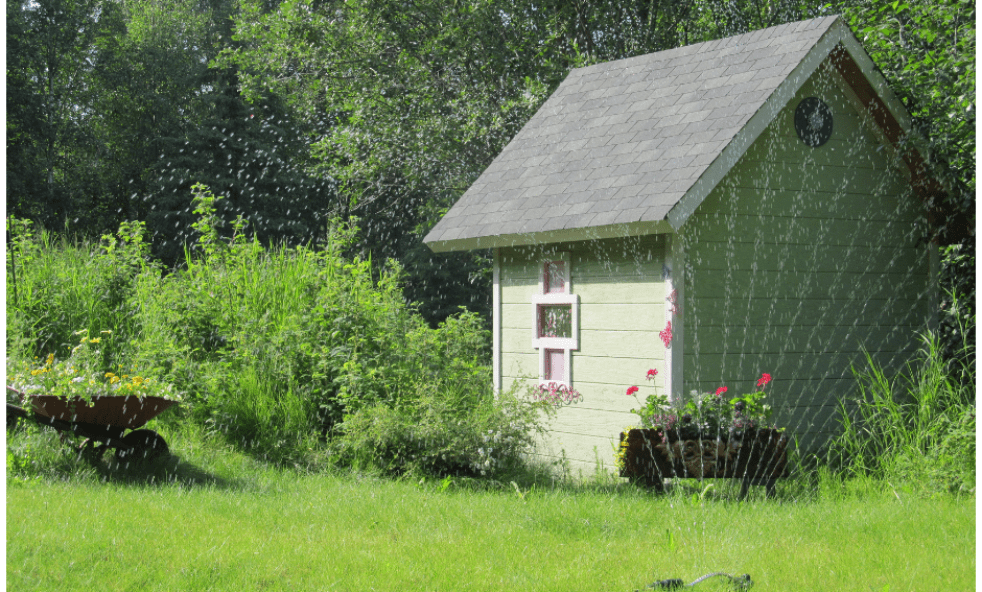
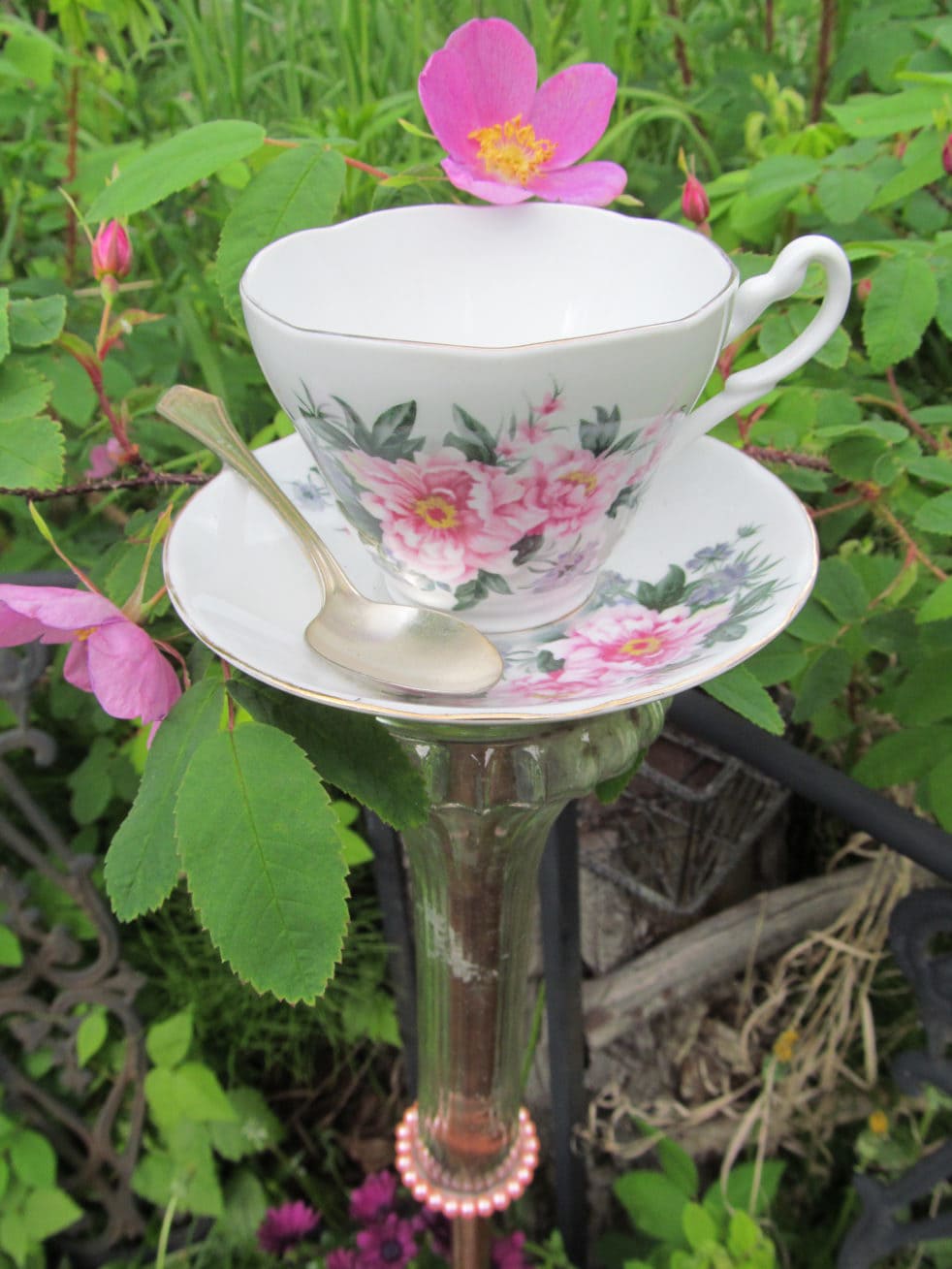
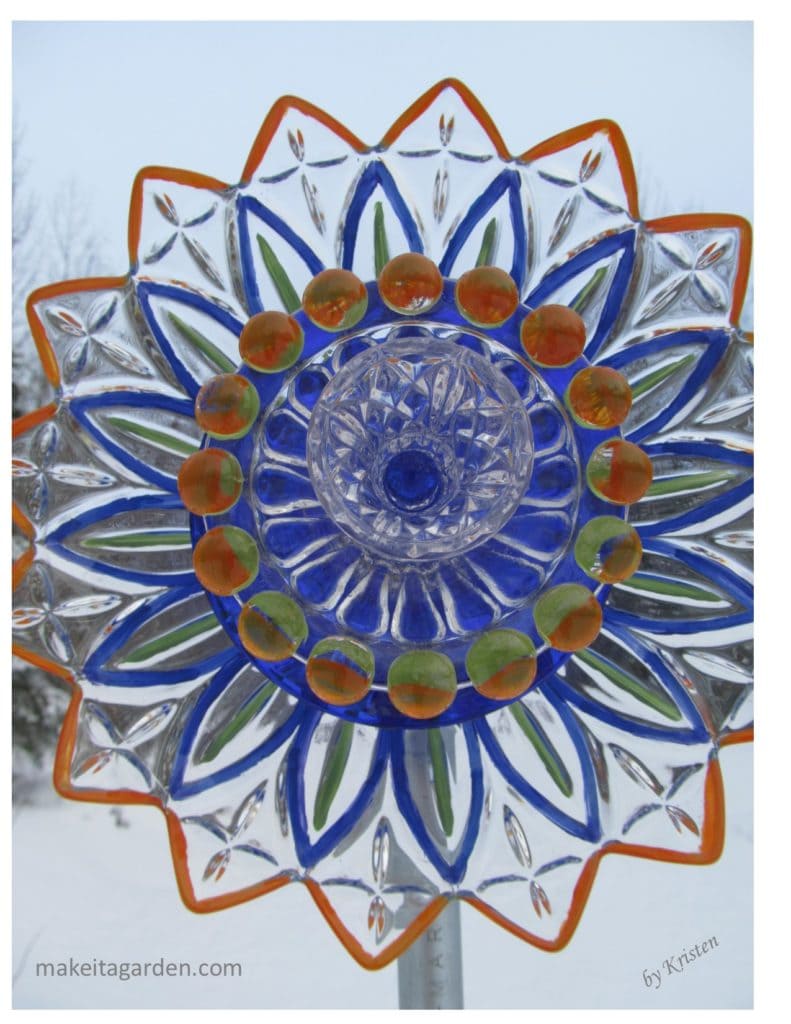

I’ve had many problems with silicone and glues. I found silicone couldn’t withstand sitting in water, i.e. after a rain when water puddled in flat area of bird bath, etc. Thank you very much for all your valuable advice.
Thanks for the valuable info, Holly! While silicone is water proof, it’s different altogether if it is immersed in water and sits in water for prolonged periods. I just made a little table-top fountain and discovered a silicone product made for the inside of a fish tank. You may wish to try AQUEON. It’s 100% silicone and Clear, but is also made for water contact, and is what aquarium hobbyists use to seal INSIDE of the tank. I found it at Pet Zoo. It’s what I use now for any figurine inside a teacup garden stake or anything that may be immersed in rain water for prolonged periods (or at least until I can empty it out.) You may want to give it a try! If you do, let me know how it went. Thanks so much for visiting my blog and for taking the time to comment! ~ Kristen
I use DAP Auto/Marine Silicone glue, and it works fine.
Thanks! Yes Silicone is a very good product for glass garden art. Glad you found something that works. I’ll pass it along. ~Kristen
Would either of these glues work for wine corks? I want to make a birdhouse with them, but am concerned about it staying together outdoors, especially if it’s actually used by a bird!
I have not done any cork projects, so I dunno. Both products state that they adhere to multiple hard surfaces, but cork isn’t specifically mentioned. Sometimes, you just have to experiment and see. I just did a quick Google search and found THIS: Gorilla White Waterproof Polyurethane Glue:
1) Expands into materials (cork is porous)
2) Waterproof
3) Indoor and outdoor
So you might experiment with that product, OR try 100% silicone for exterior/doors & windows. Silicone is a sealant, but works well as a glue and would be easy to work with for your type of project. I’d love to hear back from you on what worked and if it endured over time in the outdoors.
I had lots problems with E6000 here in Texas. Our summers get pretty hot so I guess that tge problem. Going to try the silicone next time to see if it works better.
Yes, please let me know how 100% silicone performs in TX. It is supposed to be heat resistant to 400 degrees. Make sure you get the kind for exterior doors and windows. When I first started making dish flowers and such several years ago, I learned by doing research that glue is regional. What works in one part of the country may not work in another. E-6000 is great for many things, but just cannot withstand high outsid temps.
I’ve been creating recycled glass yard art since 2013. I did use the silicone initially but had poor results. I use E 6800 which has proved to be my reliable choice for many years.
Oh GOOD! Glue is so regional! E-6000 also works very well in my area, as our climate is cooler during the summer. We may get a few unusually hot days, but not like other places.
I have used E6800 but have high sensitivity to smells. I can hardly stomach the odor. I’m assuming you don’t have that issue?
In one of my other tutorials comparing various glues, I DO mention that E-6000 has a strong odor that some people may not like. The manufacturer wrote on the package itself that people should have a source of fresh air when using it…open a window etc. That being said, everyone reacts to smells differently. The one that really gets to me is JB Weld epoxy. I don’t particularly like the chemical smell E-6000 gives off, but it doesn’t bother me. The Silicone is low odor. Bottom line, glue (and its various odors) come with the territory for any crafter or wood worker.
I was disappointed that you didn’t mention that not cleaning your glass pieces thoroughly can make your glue fail. I like to wash and dry my glass and then wipe them off with rubbing alcohol.
You’re kidding, right? This info appears not once, not twice, but THREE TIMES in this article! If one is quickly scrolling/speed reading, they could be overlooked. I’ll share them here for the benefit of other readers who may have missed it: The FIRST mention is near the top under the 2nd Heading where it says: “substances on the surface that interfere with bonding (wax, grease etc)”
The SECOND mention is further down under the heading “Other Problems With Bonding”. Again, advice is given to wash dishes well and inspect carefully before starting your project. The 3rd mention is the last heading at the bottom “A Few Things To Remember”. I wrote (3rd time) “Make sure surfaces are clean and free from oils, residue…” So IMPORTANT to me is the topic of prepping dishes, that I wrote a post about HOW to Clean Glass beforehand. Here’s the link: https://makeitagarden.com/how-to-get-sparkly-clean-glass-for-garden-art/
While dishes may “Look” clean, even after washing, I always feel for the presence of grease or oils and I have sometimes washed a plate 2 or 3 times. Alcohol does help, but if not, I try other things, as do I encounter this problem from time to time with thrifted dishes. Thanks for visiting my web site and have fun creating!
I wanted to say I found the one that works its a Silicone adhesive that I can say works, I use it on everything, I have pieces I made 6 r more years ago, and they r not all standing to to mowing and rocks braking them , I live in the south where the Humidity is off the chart, and it does not Effects them at all, and if it brakes it will brake beside the glue , the glue can hold up I can show you pictures of when I made the piece, and show u the pieces now, it took a long time for me to figure it out and cost me a lot of money wasted, but now , I can honestly say, this works
Yes, all true of 100% silicone. (the type for exterior doors and windows) The product was first made and intended to seal around the outside of doors and windows after installment. That meant that it couldn’t melt in the heat, or dry out and become brittle and fall apart. Silicone has a temperature range from -60 (below zero) to +400 degrees. That’s why it soon became the #1 “glue” used by those who make outdoor garden art. And it was because of its popularity with crafters that GE began to make it in smaller, more manageable packaging which eliminated need for a clumsy caulking gun!
Like you, I live in Alaska too. Do you leave your tart art outside during the Winter? Or do you include them in the annual “yard pick up” each late Fall before everything freezes to the ground and gets covered up by our beautiful snow?’
I always recommend taking the flowerhead off the post and storing it over winter. It’s made to come off the post and the post can stay in the ground. And that’s what I do with my pieces as well. Just in case rocks fly from road sanders or snow blowers. If there’s a lot of snow…like this year…and a totem or birdbath or dish flower gets buried, a moose trudging across the lawn or the snow plow guy could end up damaging something beneath the surface. But I did an experiment with some ceramic dish flowers one year, leaving them out all winter. They did just fine. It’s not the cold or the snow, but just more potential for damage.
Has anyone use clear gorilla glue?
“Gorilla” is just a brand name. There are several different types of glue that Gorilla makes. I do believe they make a clear-ish silicone similar to GE, except that GE is 100% Silicone and Gorilla’s is 90% (or 95%?), but it would work fine for outdoors. The number one issue for glue is that it be made to withstand outdoor conditions, including HEAT. Most glues say on the package what the heat rating is…sometimes you have to read the fine print; OR, you could research it on-line. GE also makes a 100% clear caulk, but it is intended for kitchen and bath. I don’t know what the heat rating is. The Outdoor/Exterior GE product is kind-of clear, but if you apply it properly and smooth the bead out, it’s hardly visible.
Thank you; this is just the kind of information I’ve been looking for. Very helpful!
You’re very welcome. I’m happy to share to be of help! Figured that if I was encountering issues, others would, too.
I am a beginner at making the garden flowers and I love the information and photos you have shared.
I just finished 2 layers of cut glass plates, the largest one I painted and the flower turned out beautifully.
But the mounting back came off the of the largest plate?? The glue was tacky to the touch. It had cured for at least 48hrs before putting it outside. Not sure if because the cut glass back didn’t have enough area to make a contact or if I didn’t have enough glue. I used the GE silicone glue.
Any suggestions as to why I do now?
Thanks
What did you use to mount your plate? Silicone is really a caulk (not a true glue) and is best for glass or ceramic surfaces…as in gluing 2 plates together one on top of the other. Betting the silicone bonded well with the back the plate, but not with whatever was used for the backing. Since it was cut glass, you may be right about surface to surface contact. You’d have to use more glue to fill up the ‘cut’ parts and maybe apply to a wider area. A smooth surface would work better.
The only other thing I can think of is perhaps some substance on the plate or mounting item that interfered with the silicone. Oil, grease, wax, (??). This is why I recommend drilling, b/c you can avoid those problems. Just so you know…I didn’t drill either when I first started. But because of all the frustrations of trying to find a method of mounting the plates that would work, I eventually learned how to do it. If you can provide a bit more info, I can probably have a solution for you. Thanks bunches…I’m happy you’re making plates, and loving your first flowers!
I read one person’s post about sanding the parts of the plates that needed to be glued. She also said that she used the new E6000 premium. I used it to make my 1st glass flower art. I worried about how it would hold up to a very heavy base plate. The whole flower probably weighed 10 pounds, not including the stake. So far, so good. It does smell but I had ventilation. How does silicone hold up to large, heavy pieces? Thanks for any input.
They are two different products. E6000 is a true glue. Silicone is a sealant or “caulk”. This is the first I’ve heard about the new E6000 premium so I haven’t used it yet. But E-6000 has a low heat-rating. Many glues and epoxies are quite strong but do better in an indoor application. They might not hold up in high heat if you live in a hot climate. In some areas with milder weather, E-6000 performs just fine. It’s something you’ll have to experiment with. 100% SILICONE/Exterior is a product used to seal around the outside of a window, so it is made for glass in exterior conditions. It is heat-rated to 400 degrees. It remains pliable in both extreme hot and cold. It will not dry out, and crumble apart, nor soften in higher temperatures. Silicone is quite strong. Again, it’s not the strength, but the heat factor. That’s what you most want to pay attention to. Here’s the data sheet https://eclecticproducts.com/wp-content/uploads/2023/07/E6000-PREMIUM-TDS-USA_Rev-0.pdf
I found this a very interesting article. I’ve been making flowers for 15 years or more and the only options I had was the E6000 and I did use epoxy putty for the very back. I never had anything fall apart in the heat, but I think the heat may have contributed to ruction when we had the unusual freeze that lasted seven days. I’ve also started using Lexel. It’s ultra clear. I’m I’m interested in any input that anyone has about it.
https://pdf.lowes.com/productdocuments/cbcaa1b2-a51b-4d22-b73d-11d82a4c1e22/61355322.pdf?_gl=1*mdwgyb*_gcl_aw*R0NMLjE3MDUwOTk4OTYuQ2p3S0NBaUE0NE90QmhBT0Vpd0FqNGdwT2RWUG5URjZ1MWVpU19QRllLTGc3NW5uU1lCUzFlNkRhYm1vbGVGSUlhOGJDZks3UmxBZHFSb0N4RG9RQXZEX0J3RQ..*_gcl_dc*R0NMLjE3MDUwOTk4OTYuQ2p3S0NBaUE0NE90QmhBT0Vpd0FqNGdwT2RWUG5URjZ1MWVpU19QRllLTGc3NW5uU1lCUzFlNkRhYm1vbGVGSUlhOGJDZks3UmxBZHFSb0N4RG9RQXZEX0J3RQ..*_gcl_au*MTA1NzE2NTY3Ni4xNzA1MDk5ODk1 OK
I also use a turntable when applying that adhesive, which makes it much easier to get a smooth line.
Thanks for visiting my site and for the data on Lexel. I have not used Lexel, but others have with success. HEAT is the main reason why glue softens or dries out and crumbles apart. Therefore, what works for me and what works for you might not work for someone else due to their climate. (AZ, CA, TX etc. in the United States) I always say, if you found something that works (and you have lots of experience with this craft)…great! Lots of glues are water proof or water resistant and have a rubbery,flexible quality. I always look for the heat rating on the product. For instance, according to the manufacturer, E-6000 has a heat rating of 180. Lexel (according to the spec sheet you sent) appears to have a heat-rating of 200 degrees. Although it wasn’t called a “heat rating”. In my state, either product will probably do just fine for those insisting that the glue be 100% clear. However, in other locales, folks may just have to experiment. Glass and ceramics absorb and retain heat. Glass dishes can even get hot if left for many hours in direct sun. After a few days of this, a dish flower may in fact come apart…the weight of all those plates. By comparison, 100% silicone (for exterior) is heat rated to 400 degrees. I personally use silicone. While it’s not as clear as the other products, applied to the backside of plates, it doesn’t really show. But again, glue choice is completely up to the maker. By the way, I love the turntable idea!
Great article. Question…one of my vases broke on my totem…not the glue, but the glass itself. Now I want to dissolve the GE silicone to remove that broken piece. Suggestions? Thx
Bummer on the totem. But fixable, as you indicated. Is the broken piece still attached to the rest, or not? If it is still attached do this: You should NOT have to dissolve silicone. If possible, use a razor blade or retractable blade tool to cut around (or through) the silicone. You made need to break that glass vase more (if possible) to make it easier to handle and work with. Just use a back and forth sawing motion, a little at a time. Silicone is like rubber. As a caulk, it’s made to seal around the outside of a window. When the installer replaces a window, he just cuts the seal to remove the old window. So the same for you, only on a smaller scale. I have had to do this when replacing a vase on a table stand I made. Boy, am I glad I used silicone!
If NOT still attached: you can scrape the remnant off. However, there probably is some product you can use to dissolve silicone…but sorry, I don’t know what that is, as I’ve never had to use a dissolver. But you could ask at your local hardware store or look it up on-line. Read the fine print to make sure it works on silicone. I admire you for wanting to fix it, rather than throw away. Let me know how it goes! – Kristen
Thank you. Very informative.🌺
I use gorilla glue clear grip. Works great in heat and water
Thanks for the tip, I’ll check it out. For the record, I can’t recommend a glue I haven’t personally used, but a lot of crafters desire a clear adhesive. I want to give it a try, and if all goes well, I’ll update my glue posts to include it! 🙂
Great article. Do you have any other articles (or recommendations ) for a wooden spool tabletop? I have been told not to contact the glass directly onto the wood but to add cement board to the wooden surface. Which glue / silicone would you recommend for this project. It will be heavy so table needs to stay outside in hot summer heat and freezing cold winter temperatures covered with snow.
Sounds like a great project. I love spools! But I’ve not worked with cement board before. I do know that crafters who do mosaic…even mosaic on glass or mirror surfaces or on wood use silicone. But it’s a different form of silicone. I think it’s clearer and thinner than the standard stuff in a tube. You might want to inquire at the hardware store. Perhaps checking at your local art glass store or a glass dealer? I’m thinking some type of silicone product for its excellent outdoor qualities.
Thank you so much for this extremely clear and informative article. I have not yet made any garden art, but I hope to one day, and your info will make success much more likely for me.
I think I will try making some kind of winter/ holiday decoration first, so I won’t have to worry about the heat. (We rarely get temps below 30 degrees, so cold won’t be a problem either…)
Thanks again!
(Oh, and you are the first blogger I’ve seen who actually responds to every/ most of your comments! Thank you on behalf of everyone else for taking the time to do that!)
I love making garden art, and love being able to help others by sharing knowledge and experience. When I come up against a problem or something doesn’t work out, I attempt to find out why. I also keep an ear out for problems folks experience and in the process, I’ve learned quite a bit as well!
Love this article…answered so many questions I had! I am just starting my “adventure” with recycled glass windows and yard totems. I was considering using B7000 as opposed to the E6000. Any thoughts on that? Although your article has me pretty much convinced to go the silicon route. Also, do you think a glass mosaic would work on a large entry door window…or would there be to much vibration from using the door?
Not heard of B7000, but for outdoor use, you always want to look at temperature. All glues are rated for such. Super quick research on B7000 shows 90-C which equates to 194-F, so about 200. That is still a very low heat threshold (though better than E-6000). Some 2 part Epoxy’s are rated at 200. As mentioned in the article, it would depend on where you live and your summer temperatures. If you have prolonged heat, I’d stick with the silicone calk products. They are intended to caulk around the exterior of doors and windows. But you could certainly experiment and discover what works best for you.
As for the mosaic: are you mounting it on the door, or replacing existing glass with your mosaic panel? I do not have enough experience to confidently advise here. I would talk to a contractor or someone in your community that sells glass or works with glass arts. I have heard about those who have used thick glass platters for a transom or green house windows- that the glass is often thicker than the glass panes for standard windows. Many entry doors have glass panels in them that aren’t bothered by ‘vibrations’, so my guess is that if the panel was secure top and bottom and sides…so it’s not swinging loose, it’s probably going to be ok.
Has anyone had a problem with E-6000 running out of the tube after an application? Also trying to clean the tube to put the cap on? Lost a who!e tube just trying to stop it from coming out when I was doing dish flowers.
E-6000 is thin, runny and stringy. You have to either prop it tip end up when using it or put the cap back on. It you just set it on its side the product may continue to run out on its own. Other glues can do this as well. When I use E-6000, I always wipe the tip and prop it so the glue tip is in an upward position.
The best information I have found to date, I have made two glass mushrooms using E6000, both came apart in the sun, I was very disappointed, some glues are quite expensive so I haven’t tried again, thankyou for all this info. I look forward to starting from scratch.
Sadly, many tutorials show E-6000. Mainly b/c it dries clear and isn’t as noticeable. Most do not do the research and only care about shooting out another You Tube or blog post to benefit their website or You Tube Channel. I discovered early on the discussions makers were having b/c their crafts were coming apart. There’s a huge difference between a “glue” and a caulk. E-6000 is a good craft glue for an INDOOR project. It’s just not intended to hold up to high temperatures. I have since researched the heat-rating for several products in order to help readers have success with their outdoor garden art b/c I hate to see someone give up out of frustration. 🙂